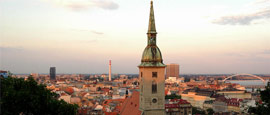Situated high above the Danube, this 17th-century Habsburg castle is often called 'the upturned table' due its four octagonal corner towers. Parts of the castle are currently closed for major renovation, but some areas have now reopened (including its precincts, which contain a small museum) and tours are available, though the best reason to take a stroll up here is for the view over the town and the Danube.
Things to see in Bratislava
Tourist offices
Address: Klobučnícka 2 (Old Town), Bratislava, Slovakia
Tel: +421 2 5441 9410.
visit.bratislava.sk
Another tourist information office is located in the arrivals hall A at Bratislava International Airport (tel: +421 2 3810 3988).
The Bratislava City Card (BCC) offers free travel on public transport plus small discounts at around 60 institutions and services including museums, galleries and shopping and includes a free walking tour of the old town in season. It is available for one, two or three days, from tourist offices and leading hotels.
Michael's Tower's blue copper roof is one of the symbols of Bratislava. The best views in the city are from the viewing platform of the tower, which dates from the 14th century. To the south, you can see the baroque town houses of Michalská Street, to the west the red tiled houses at the foot of the castle. Entrance to the tower is via the Museum of Arms, a small museum of old weapons and firearms. The admission charge includes entry to the Pharmaceutical Museum a few doors away at Michalská 24.
Undoubtedly the city's most distinctive modern structure is the New Bridge (also known as the SNP Bridge, after the Slovak National Uprising), which spans the Danube below Bratislava Castle and is suspended from a single pylon. The all-steel bridge was built between 1967 and 1972 and is just over 431m (1,414ft) long. There’s a restaurant at the top of the pylon, though the best view of the bridge itself is from the castle.
This late 18th-century Baroque Palace hosts the signing of the Pressburg peace treaty (in its Hall of Mirrors) after Napoleon's armies defeated Austria at Austerlitz in 1805. It is also home to a fine collection of 17th-century English tapestries, found during restoration hidden behind the wallpaper.
From the 16th to the 19th centuries, this 13th-century Franciscan cathedral was the coronation place of four Hungarian monarchs, including Empress Maria Theresa. Its Chapel of St John is regarded as a gothic masterpiece and the crypt is also worth a visit. The cathedral accepts visitors by prior arrangement or between mass times.
This branch of the City Gallery contains Baroque painting and sculpture from Central Europe. There are also German, Dutch and Italian prints, and the 290 copper engravings for the building’s original 18th century wallpaper decoration.
This branch of the City Gallery contains Gothic, 19th-century, 20th-century and contemporary Central European and Slovak works of art; the most interesting works are the latter, particularly the astonishing trompe l'oeil Passage by Matej Kreén. There’s also a permanent exhibition of a Celtic coin mint.
With sections dating back to the 14th century, the Old Town Hall offers a mix of architectural styles, including a Renaissance courtyard from 1581 and a tower that offers views of the city. It also houses the Bratislava City Museum, which includes artefacts from the area from the Neolithic period to the 1930s.
Housed in an impressive neo-classical building originally built in the 18th century, the Slovak National Gallery overlooks the Danube and contains works of art from the 13th century to the present. Many of the temporary exhibitions take on the country's past and Slovakia's intercultural history, offering a lively and colourful insight into Slovakia's history with all exhibits also captioned in English.
Among the most charming aspects of the Slovak capital are the many humorous outdoor sculptures dotted around the old town centre. Forget austere sculptures of kings, politicians and equestrian-mounted generals, and instead go in search of Napoleon’s Soldier (leaning nonchalantly on a bench in Hlavné námestie), Paparazzi (on a corner of Laurinská), Schöner Naci (an early 20th century dandy who doffs his hat to passers-by on Rybárska), and Čumil (also known as Rubberneck, the first of these sculptures, who peeps out of a manhole cover on Panská).
Do you have any Feedback about this page?
© 2025 Columbus Travel Media Ltd. All rights reserved. No part of this site may be reproduced without our written permission, click here for information on Columbus Content Solutions.








 You know where
You know where